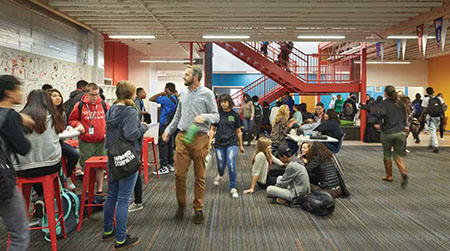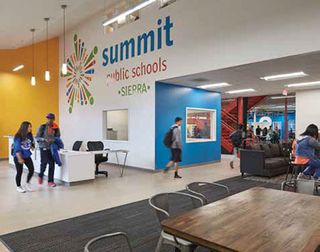LEARNING TECH: NOW IT’S GETTING PERSONAL

While Google Apps for Education, Microsoft productivity tools, and—latest to the scene—Amazon Inspire, have made inroads into the educational arena, Facebook’s partnership with Summit Public Schools reaches new heights in connecting with students and changing the way educators approach personalized learning.
In 2000, hundreds of Silicon Valley parents and community members came together to reimagine the American high school. Summit Public Schools has since expanded into eight innovative schools around the Bay Area. Students log onto the Summit Personalized Learning Platform to access their entire curriculum, pick and choose projects, and selfdirect their learning, all at a comfortable pace.
Facebook CEO Mark Zuckerberg visited Summit in 2014. Inspired, he offered Facebook’s engineering expertise to help turn the Summit Personalized Learning Platform into a dynamic, scalable platform that could provide schools across the U.S. with the resources they need to bring personalized learning into the classroom.
For the last two years, Facebook engineers have been working with Summit educators to make the platform an even more powerful tool that is free for students, teachers, and parents. Through a program called Summit Basecamp, schools adapt personalized learning to meet the specific needs of their individual school populations.
LEVELING THE PLAYING FIELD
Between classes at Summit Sierra in Seattle, WA Making sure no child slips through the cracks is a key benefit to personalizing the student learning process. The Summit Personalized Learning Platform is heavy on analytics and real-time assessment, allowing teachers and students to pinpoint areas of need while avoiding wasted time rehashing mastered skills.
“We know that students learn best when they are getting constant feedback from their peers, from themselves, from their teachers,” says Lizzie Choi, Summit’s Chief Program Officer leading the Summit Basecamp program. “Because students come from different families and different backgrounds, we want to make sure that they are able to move at a pace and progression that honors their prior content knowledge. This way, every single student is able to reach their unique potential.”
Having each student work at their own pace can relieve the stress or stigma for those falling behind, which could have discouraged them from class participation, often leading to a further decline.
“A student told me, ‘I used to raise my hand when I didn’t understand something, and then I would wait for the teacher to talk their way through 30 students and eventually get to me. Now, when I don’t understand or remember something from last year, I can just pull it up.’”
LEARNING CURVES
Summit Sierra in Seattle, WA Students might initially find the freedom challenging. However, unlike the freshman year of college, they can adjust to self-motivation while safe at home and with parental support.

“We provide pace guidance. If they want to finish the content by the end of year, they should be moving at ‘x’ pace,” says Sam Strasser, one of the leaders on the Facebook team building the Summit Personalized Learning Platform. “There are built-in visual cues to demonstrate if they are ahead, behind, or right at that goal. When we report on progress to students and their families, we focus on the material they have mastered and what they have left to master. One of the most exciting things we saw was that a lot of students started the year slowly as they learned the new system and adjusted to the fact that they have control of their learning environment…and then they picked up the pace very fast. In the end, the steep learning curve resulted in higher academic achievement.”
Educators also face some adjustments, but rewards soon follow.
“I think any time you ask teachers to rethink their practice, there’s always that time up front,” says Choi. “But teachers have told us it isn’t increasing their workload, just transitioning how they spend their time. Now they are able to do the highest leverage activity possible. Initially, they thought they wouldn’t have the same teacher-student relationship, but now they are able to have a deeper and richer connections. Now they are able to build strong culture and have a stronger community in the class, making sure their students feel deeply known and deeply safe in the learning environment at school. One teacher even put off her retirement over the excitement of finally getting back to the reason she went into teaching—making a difference in students’ lives.”
THE BIG PICTURE
Preparing students for a successful future is the end goal for this or any personalized learning platform.
“We want to make sure students are connecting their long-term goals with their daily actions; who they want to become should connect with what they want to be about, in school today,” says Choi.
“What kind of college do I want to attend? What kind of person do I want to be? What information do I need to have to make good choices? If I want to go to Stanford and these are the expectations of me this year, then what are the actions and behaviors I need to embody? What are the skills I need to learn in order to do that, so I can have a sense of whether I am on track to meet my long-term goals?”
Using this platform, students can set goals and record their work; teachers, mentors, and parents can all join in to support the students to make sure they are on the path to meet their goals before it is too late.
“Whether it is dissecting political speeches or writing letters to their city council, we want students to rely on their inner compass,” says Choi. “We want to make sure students are deeply engaging with authentic educational experiences because we know the problems of tomorrow are unknown today.”
SUMMIT BASECAMP PROVIDES PARTNER SCHOOLS WITH A NUMBER OF SUPPORT RESOURCES.
Unlimited access to the Summit Personalized Learning Platform, the online tool that helps power the personalized learning classroom, so teachers and students can create and follow learning plans and track progress toward goals.
Complete curricula for English, math, science, and social studies for grades 6-12. Receiving the “gold stamp” from SCALE at Stanford University, this project-based curriculum is teacher-created, standards-aligned, and customizable. It includes nearly 200 deeper learning projects and over 700 “Playlists” (libraries of learning content) and assessments.
Ongoing support and mentorship to help implement and adapt personalized learning for each school, including best practices from Summit Public Schools and other schools currently in the Summit Basecamp program.
A “community of practice” that brings together teachers and administrators from across the country, doing the same work, to share experiences and ideas.
Tech & Learning Newsletter
Tools and ideas to transform education. Sign up below.
Sascha has nearly two decades of experience as a freelance journalist writing for national magazines, including The Washington Post, LA Times, Christian Science Monitor, National Geographic Traveler, and others. She writes about education, travel and culinary topics.











